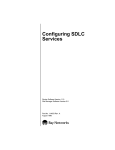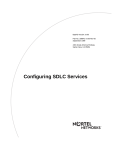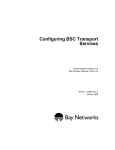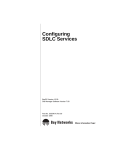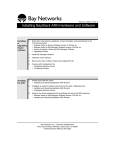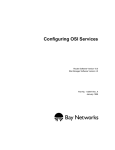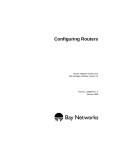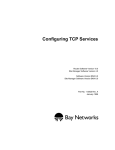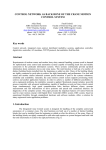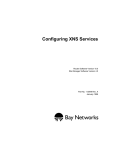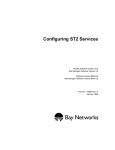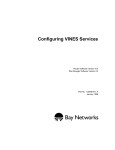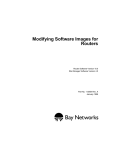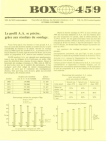Download Avaya Configuring SDLC Services User's Manual
Transcript
Configuring SDLC Services Router Software Version 10.0 Site Manager Software Version 4.0 Part No. 112921 Rev. A January 1996 4401 Great America Parkway Santa Clara, CA 95054 8 Federal Street Billerica, MA 01821 Copyright © 1988–1996 Bay Networks, Inc. All rights reserved. Printed in the USA. January 1996. The information in this document is subject to change without notice. The statements, configurations, technical data, and recommendations in this document are believed to be accurate and reliable, but are presented without express or implied warranty. Users must take full responsibility for their applications of any products specified in this document. The information in this document is proprietary to Bay Networks, Inc. The software described in this document is furnished under a license agreement and may only be used in accordance with the terms of that license. A summary of the Software License is included in this document. Restricted Rights Legend Use, duplication, or disclosure by the United States Government is subject to restrictions as set forth in subparagraph (c)(1)(ii) of the Rights in Technical Data and Computer Software clause at DFARS 252.227-7013. Notice for All Other Executive Agencies Notwithstanding any other license agreement that may pertain to, or accompany the delivery of, this computer software, the rights of the United States Government regarding its use, reproduction, and disclosure are as set forth in the Commercial Computer Software-Restricted Rights clause at FAR 52.227-19. Trademarks of Bay Networks, Inc. ACE, AFN, BCN, BLN, BN, CN, FRE, LN, Optivity, SynOptics, SynOptics Communications, Wellfleet and the Wellfleet logo are registered trademarks and AN, ANH, ASN, BaySIS, BayStack, BCNX, BLNX, BNX, EZ Internetwork, EZ LAN, FN, PathMan, PhonePlus, PPX, Quick2Config, RouterMan, SPEX, Bay Networks, Bay Networks Press, the Bay Networks logo and the SynOptics logo are trademarks of Bay Networks, Inc. Third-Party Trademarks All other trademarks and registered trademarks are the property of their respective owners. Statement of Conditions In the interest of improving internal design, operational function, and/or reliability, Bay Networks, Inc. reserves the right to make changes to the products described in this document without notice. Bay Networks, Inc. does not assume any liability that may occur due to the use or application of the product(s) or circuit layout(s) described herein. Portions of the code in this software product are Copyright © 1988, Regents of the University of California. All rights reserved. Redistribution and use in source and binary forms of such portions are permitted, provided that the above copyright notice and this paragraph are duplicated in all such forms and that any documentation, advertising materials, and other materials related to such distribution and use acknowledge that such portions of the software were developed by the University of California, Berkeley. The name of the University may not be used to endorse or promote products derived from such portions of the software without specific prior written permission. SUCH PORTIONS OF THE SOFTWARE ARE PROVIDED “AS IS” AND WITHOUT ANY EXPRESS OR IMPLIED WARRANTIES, INCLUDING, WITHOUT LIMITATION, THE IMPLIED WARRANTIES OF MERCHANTABILITY AND FITNESS FOR A PARTICULAR PURPOSE. In addition, the program and information contained herein are licensed only pursuant to a license agreement that contains restrictions on use and disclosure (that may incorporate by reference certain limitations and notices imposed by third parties). Bay Networks Software License Note: This is Bay Networks basic license document. In the absence of a software license agreement specifying varying terms, this license — or the license included with the particular product — shall govern licensee’s use of Bay Networks software. This Software License shall govern the licensing of all software provided to licensee by Bay Networks (“Software”). Bay Networks will provide licensee with Software in machine-readable form and related documentation (“Documentation”). The Software provided under this license is proprietary to Bay Networks and to third parties from whom Bay Networks has acquired license rights. Bay Networks will not grant any Software license whatsoever, either explicitly or implicitly, except by acceptance of an order for either Software or for a Bay Networks product (“Equipment”) that is packaged with Software. Each such license is subject to the following restrictions: 1. Upon delivery of the Software, Bay Networks grants to licensee a personal, nontransferable, nonexclusive license to use the Software with the Equipment with which or for which it was originally acquired, including use at any of licensee’s facilities to which the Equipment may be transferred, for the useful life of the Equipment unless earlier terminated by default or cancellation. Use of the Software shall be limited to such Equipment and to such facility. Software which is licensed for use on hardware not offered by Bay Networks is not subject to restricted use on any Equipment, however, unless otherwise specified on the Documentation, each licensed copy of such Software may only be installed on one hardware item at any time. 2. Licensee may use the Software with backup Equipment only if the Equipment with which or for which it was acquired is inoperative. 3. Licensee may make a single copy of the Software (but not firmware) for safekeeping (archives) or backup purposes. 4. Licensee may modify Software (but not firmware), or combine it with other software, subject to the provision that those portions of the resulting software which incorporate Software are subject to the restrictions of this license. Licensee shall not make the resulting software available for use by any third party. 5. Neither title nor ownership to Software passes to licensee. 6. Licensee shall not provide, or otherwise make available, any Software, in whole or in part, in any form, to any third party. Third parties do not include consultants, subcontractors, or agents of licensee who have licensee’s permission to use the Software at licensee’s facility, and who have agreed in writing to use the Software only in accordance with the restrictions of this license. 7. Third-party owners from whom Bay Networks has acquired license rights to software that is incorporated into Bay Networks products shall have the right to enforce the provisions of this license against licensee. 8. Licensee shall not remove or obscure any copyright, patent, trademark, trade secret, or similar intellectual property or restricted rights notice within or affixed to any Software and shall reproduce and affix such notice on any backup copy of Software or copies of software resulting from modification or combination performed by licensee as permitted by this license. Bay Networks, Inc. 4401 Great America Parkway, Santa Clara, CA 95054 8 Federal Street, Billerica, MA 01821 Bay Networks Software License (continued) 9. Licensee shall not reverse assemble, reverse compile, or in any way reverse engineer the Software. [Note: For licensees in the European Community, the Software Directive dated 14 May 1991 (as may be amended from time to time) shall apply for interoperability purposes. Licensee must notify Bay Networks in writing of any such intended examination of the Software and Bay Networks may provide review and assistance.] 10. Notwithstanding any foregoing terms to the contrary, if licensee licenses the Bay Networks product “Site Manager,” licensee may duplicate and install the Site Manager product as specified in the Documentation. This right is granted solely as necessary for use of Site Manager on hardware installed with licensee’s network. 11. This license will automatically terminate upon improper handling of Software, such as by disclosure, or Bay Networks may terminate this license by written notice to licensee if licensee fails to comply with any of the material provisions of this license and fails to cure such failure within thirty (30) days after the receipt of written notice from Bay Networks. Upon termination of this license, licensee shall discontinue all use of the Software and return the Software and Documentation, including all copies, to Bay Networks. 12. Licensee’s obligations under this license shall survive expiration or termination of this license. Bay Networks, Inc. 4401 Great America Parkway, Santa Clara, CA 95054 8 Federal Street, Billerica, MA 01821 Contents About This Guide Audience ........................................................................................................................... xi Before You Begin .............................................................................................................. xi Bay Networks Customer Support .....................................................................................xii CompuServe ..............................................................................................................xii InfoFACTS .................................................................................................................xiii World Wide Web ........................................................................................................xiii How to Get Help ..............................................................................................................xiv Conventions .....................................................................................................................xiv Ordering Bay Networks Publications ............................................................................... xv Acronyms ......................................................................................................................... xv Chapter 1 Synchronous Data Link Control Overview SDLC Networking ...........................................................................................................1-1 SDLC Features ...............................................................................................................1-2 Link Station Roles ....................................................................................................1-2 Transmission Capabilities .........................................................................................1-2 Physical Connections ...............................................................................................1-3 Frame Format ...........................................................................................................1-3 Using APPN Services with SDLC ...................................................................................1-4 Using DLSw Services with SDLC ...................................................................................1-4 For More Information about SDLC ..................................................................................1-4 Chapter 2 SDLC Implementation Notes Link Stations ...................................................................................................................2-1 Synchronous Line Parameters .......................................................................................2-1 SDLC Timers ..................................................................................................................2-2 Configurable Window Size ..............................................................................................2-2 v Chapter 3 Enabling SDLC Services Enabling SDLC on an Interface ......................................................................................3-1 SDLC Line Parameter Descriptions ................................................................................3-3 Chapter 4 Editing SDLC Parameters Using the Parameter Descriptions ..................................................................................4-1 Accessing SDLC Parameters .........................................................................................4-2 Editing SDLC Global Parameters ...................................................................................4-3 Editing SDLC Interface Parameters ................................................................................4-4 SDLC Interface Parameter Descriptions ..................................................................4-6 Deleting an SDLC Interface ..........................................................................................4-14 Adding an SDLC Link Station .......................................................................................4-15 Editing SDLC Link Station Parameters .........................................................................4-17 SDLC Link Station Parameter Descriptions ...........................................................4-18 Deleting SDLC from the Router ....................................................................................4-27 Appendix A SDLC Default Parameter Settings Index vi Figures Figure 1-1. Figure 3-1. Figure 3-2. Figure 4-1. Figure 4-2. Figure 4-3. Figure 4-4. SDLC Frame Format ................................................................................1-3 SDLC Line Parameters Window ..............................................................3-2 Select Protocols Window .........................................................................3-2 Configuration Manager Window ...............................................................4-2 Edit SDLC Global Parameters Window ....................................................4-3 SDLC Interface Configuration Window ....................................................4-5 SDLC Link Station Configuration Window ..............................................4-15 Figure 4-5. Link Station Configuration Window ........................................................4-16 vii Tables Table A-1. Table A-2. Table A-3. SDLC Line Parameters ........................................................................... A-1 SDLC Interface Parameters .................................................................... A-2 SDLC Link Station Parameters ............................................................... A-3 ix About This Guide If you configure and manage Synchronous Data Link Control (SDLC) services for Bay Networks routers, refer to this guide for • An overview of the SDLC protocol and its client protocols (Chapter 1) • Implementation notes that may affect how you configure SDLC services (Chapter 2) • Instructions on enabling SDLC services on the router (Chapter 3) • Instructions on editing SDLC parameters (Chapter 4) For information and instructions on starting up and managing Bay Networks router configurations, refer to Configuring Routers. Audience Written for system and network managers, this guide describes the Bay Networks implementation of SDLC for networks containing Bay Networks routers. You should be familiar with the IBM networking concepts associated with the Systems Network Architecture (SNA) and SDLC. Before You Begin Before using this guide, you must complete the following procedures: • Open a configuration file. • Specify the router hardware, if this is a local-mode configuration file. • Select the link- or net-module connector on which you are enabling SDLC. Refer to Configuring Routers for instructions. xi Configuring SDLC Services Bay Networks Customer Support Bay Networks provides live telephone technical support to our distributors, resellers, and service-contracted customers from two U.S. and three international support centers. If you have purchased your Bay Networks product from a distributor or authorized reseller, contact the technical support staff of that distributor or reseller for assistance with installation, configuration, troubleshooting, or integration issues. Customers also have the option of purchasing direct support from Bay Networks through a variety of service programs. The programs include priority access telephone support, on-site engineering assistance, software subscription, hardware replacement, and other programs designed to protect your investment. To purchase any of these support programs, including PhonePlus™ for 24-hour telephone technical support, call 1-800-2LANWAN. Outside the U.S. and Canada, call (408) 764-1000. You can also receive information on support programs from your local Bay Networks field sales office, or purchase Bay Networks support directly from your reseller. Bay Networks provides several methods of receiving support and information on a nonpriority basis through the following automated systems. CompuServe Bay Networks maintains an active forum on CompuServe. All you need to join us online is a computer, a modem, and a CompuServe account. We also recommend using the CompuServe Information Manager software, available from CompuServe. The Bay Networks forum contains libraries of technical and product documents designed to help you manage and troubleshoot your Bay Networks products. Software agents and patches are available, and the message boards are monitored by technical staff and can be a source for problem solving and shared experiences. Customers and resellers holding Bay Networks service contracts can visit the special libraries to acquire advanced levels of support documentation and software. xii About This Guide To open an account and receive a local dial-up number, call CompuServe at 1-800-524-3388 and ask for Representative No. 591. • In the United Kingdom, call Freephone 0800-289378. • In Germany, call 0130-37-32. • In Europe (except for the United Kingdom and Germany), call (44) 272-760681. • Outside the U.S., Canada, and Europe, call (614) 529-1349 and ask for Representative No. 591, or consult your listings for an office near you. Once you are online, you can reach our forum by typing the command GO BAYNETWORKS at any ! prompt. InfoFACTS InfoFACTS is the Bay Networks free 24-hour fax-on-demand service. This automated system contains libraries of technical and product documents designed to help you manage and troubleshoot your Bay Networks products. The system can return a fax copy to the caller or to a third party within minutes of being accessed. World Wide Web The World Wide Web (WWW) is a global information system for file distribution and online document viewing via the Internet. You need a direct connection to the Internet and a Web Browser (such as Mosaic or Netscape). Bay Networks maintains a WWW Home Page that you can access at http:// www.baynetworks.com. One of the menu items on the Home Page is the Customer Support Web Server, which offers technical documents, software agents, and an E-mail capability for communicating with our technical support engineers. xiii Configuring SDLC Services How to Get Help For additional information or advice, contact the Bay Networks Technical Response Center in your area: United States Valbonne, France Sydney, Australia Tokyo, Japan 1-800-2LAN-WAN (33) 92-966-968 (61) 2-903-5800 (81) 3-328-005 Conventions This section describes the conventions used in this guide. arrow character (➔) Separates menu and option names in instructions. Example: Protocols➔AppleTalk identifies the AppleTalk option in the Protocols menu. bold text Indicates text that you need to enter and command names in text. Example: Use the dinfo command. brackets ([ ]) Indicate optional elements. You can choose none, one, or all of the options. italic text Indicates variable values in command syntax descriptions, new terms, file and directory names, and book titles. quotation marks (“ ”) Indicate the title of a chapter or section within a book. screen text Indicates data that appears on the screen. Example: Set Bay Networks Trap Monitor Filters vertical line (|) Indicates that you enter only one of the parts of the command. The vertical line separates choices. Do not type the vertical line when entering the command. Example: If the command syntax is show at routes | nets, you enter either show at routes or show at nets, but not both. xiv About This Guide Ordering Bay Networks Publications To purchase additional copies of this document or other Bay Networks publications, order by part number from Bay Networks Press™ at the following numbers. You may also request a free catalog of Bay Networks Press product publications. Phone: FAX - U.S./Canada: FAX - International: 1-800-845-9523 1-800-582-8000 1-916-939-1010 AN Access Node APPC Advanced Peer-to-Peer Communications APPN Advanced Peer-to-Peer Networking ASN Access Stack Node CP Control Point DLSw Data Link Switching FEP front-end processor IEEE Institute of Electrical and Electronic Engineers LAN local area network LLC logical link control MAC Media Access Control NetBIOS Network Basic Input-Output System NRZ non-return to zero NRZI non-return to zero inverted PDU protocol data unit PU physical unit RFC Request for Comments SAP service access point SDLC Synchronous Data Link Control SNA Systems Network Architecture (IBM) SNMP Simple Network Management Protocol XID exchange identification Acronyms xv Chapter 1 Synchronous Data Link Control Overview This chapter describes the following Synchronous Data Link Control (SDLC) features and services: • SDLC networking — Link stations — Transmission capabilities — Physical connections — Frame format • Using APPN and DLSw services with SDLC Read this chapter if you are configuring Advanced Peer-to-Peer Networking (APPN) or Data Link Switching (DLSw) networks. SDLC parameter settings can influence APPN and DLSw performance. SDLC Networking SDLC is the synchronous, bit-oriented link control protocol in the IBM System Network Architecture (SNA). SDLC’s connection-oriented protocol operates with the Data Link Switching (DLSw) protocol and the Advanced Peer-to-Peer Networking (APPN) architecture. SDLC supports point-to-point and multipoint topologies. In point-to-point topologies, one SDLC device is connected to the SDLC port. In multipoint topologies, several SDLC devices are connected to the SDLC port via a modemsharing device. 1-1 Configuring SDLC Services SDLC Features You can configure most of the following features using the SDLC parameters described in Chapter 4. Link Station Roles A link station is a logical connection between adjacent nodes, where one node is a primary link station and the other node is a secondary link station. Only one link station on an SDLC line can be the primary station; all other stations on the line must be secondary. SDLC supports primary, secondary, and negotiable link stations. A primary link station does the following: • Controls a data link • Issues commands • Initiates error-recovery procedures A secondary link station receives commands and responds to primary link station polls. In DLSw configurations, a Bay Networks router must be configured as a primary or a secondary link station. When configured as a primary SDLC link station, the router communicates with downstream PU 2.0 and PU 2.1 nodes. When configured as a secondary SDLC link station, the router communicates with PU 4, PU 5, and PU 2.1 devices. In APPN configurations (PU 2.1 devices only), a Bay Networks router supports negotiable link stations, where the two link stations exchange XIDs to negotiate which one will be primary and which secondary. Transmission Capabilities SDLC supports full- and half-duplex transmissions over leased lines. With fullduplex, data transmissions can occur in both directions (between primary and secondary link stations) at the same time. With half-duplex, transmissions can occur in only one direction at a time. 1-2 Synchronous Data Link Control Overview Physical Connections SDLC supports communication with attached SNA/SDLC devices using V.24 (RS-232), V.35, and X.21 (nonswitched) connections. SDLC supports line speeds up to 64 Kb/s, depending on the physical connection. For example, V.24 interfaces can operate at speeds up to 19.2 Kb/s, while V.35 interfaces can operate at speeds up to 64 Kb/s. Frame Format SDLC sends and receives three types of frames: • Supervisory frames transmit ready or busy status, control polling, and request retransmission when an error occurs or when frames arrive out of sequence. • Information frames transmit data. • Unnumbered frames control initialization and status reporting. Figure 1-1 illustrates the format of SDLC frames. Flag Address Field Figure 1-1. Control Field Information Field Frame Checking Field Flag SDLC Frame Format Each frame begins with a one-byte flag that alerts the receiver to the frame’s presence. The Address field can be one or two bytes long. This field identifies the secondary link station that is communicating with the primary link station. In a poll, the Address field identifies the station being polled. In a response, this field identifies the transmitting secondary station. The Control field is one byte long and identifies the function of the frame. This field defines the frame format (supervisory, information, or unnumbered). The optional Information field is a variable-length field (the length must be a multiple of eight bits). 1-3 Configuring SDLC Services A two-byte Frame-checking field lets the receiving station check the received frame for errors. A one-byte flag ends the frame. Using APPN Services with SDLC You can configure any SDLC interface for APPN services. APPN nodes can communicate with adjacent nodes using SDLC links over point-to-point and multipoint configurations. For information on the APPN node types and how to configure APPN, see Configuring APPN Services. Using DLSw Services with SDLC You can configure any SDLC interface for DLSw services. For information on DLSw, see Configuring DLSw Services. For More Information about SDLC For more information about SDLC and IBM SNA, refer to the following IBM publications: 1-4 • IBM Synchronous Data Link Control: Concepts (GA27-3093) • IBM System Network Architecture: Technical Overview (GC30-30723) • IBM System Network Architecture: Concepts and Products (GC30-3072) • Systems Network Architecture APPN Architecture Reference (SC30-3422-3) • APPN Architecture and Product Implementations Tutorial (GG24-3669) • Data Link Switching: Switch-to-Switch Protocol RFC 1434 Chapter 2 SDLC Implementation Notes Keep the following implementation notes in mind when you configure SDLC services. Link Stations With DLSw, you can configure SDLC as a primary or secondary link station only. With APPN, you can configure primary, secondary, and negotiable link stations. You set up SDLC link stations as follows: • For primary link stations, you must configure the adjacent link station’s parameters. • For secondary link stations, you must configure the station’s own link station parameters. • For negotiable link stations, you must configure the station’s own link station parameters, as well as the parameters for a potential adjacent link station. Refer to Chapter 4 for information on configuring SDLC link stations. Synchronous Line Parameters When you add SDLC to a synchronous line, Site Manager opens the SDLC Line Parameters window, which allows you to edit the following parameters: • Clock Source • Internal Clock Speed • Sync Line Coding • Cable Type 2-1 Configuring SDLC Services • RTS Enable Chapter 3 describes how to complete the SDLC Line Parameters window. To view or change synchronous line parameters that do not appear in the SDLC Line Parameters window, edit the line parameters of the desired circuit. For information on editing other synchronous line parameters, refer to Configuring Line Services. Note: The BOFL (Breath of Life) parameter enables the transmission of proprietary Breath of Life messages over a point-to-point connection between the local router and a remote peer. Disable this parameter so that the BOFL messages do not interfere with SDLC frames. SDLC Timers SDLC uses timers to manage traffic over SDLC links. If you configure SDLC on a link with a slow baud rate, the default values for SDLC timer parameters may not be adequate for the line. You should edit the timer values whenever you adjust the speed of the line. For example, if you are using a line with a 4800 baud rate, increase the REPLYTO Timer parameter value in the SDLC Link Station Configuration window (refer to Figure 4-4) to 60 tenths of a second. Edit the REPLYTO Timer value whenever you adjust baud rate with the Internal Clock Speed parameter or the external modem baud rate. Configurable Window Size In SDLC, a window controls the number of frames that a link station can send before it receives an acknowledgment. The size of the window depends on the modulo in use in your network’s implementation of SDLC. Modulo 8 operation allows a maximum window size of 7. Modulo 128 operation allows a maximum window size of 127. For example, with a window size of 7, a link station can transmit frames 0 through 6 before requiring acknowledgment from the receiving station. The sending station will not send more frames until it receives an acknowledgment. You edit this window size with the MAXOUT parameter, described in Chapter 4. 2-2 Chapter 3 Enabling SDLC Services This chapter describes how to enable SDLC services. It assumes you have read Configuring Routers and that you have completed the following steps: 1. Opened a configuration file. 2. Specified router hardware if this is a local-mode configuration file. 3. Selected the link- or net-module connector on which you are enabling SDLC, or configured a WAN circuit if this connector requires one. When you enable SDLC services, you are required to specify only a few parameters. The Configuration Manager supplies default values for the rest. If you want to edit these parameters, refer to Chapter 4. Enabling SDLC on an Interface To enable SDLC on an interface: 1. Select SDLC in the WAN Protocols window. The Configuration Manager displays the SDLC Line Parameters window (Figure 3-1). 3-1 Configuring SDLC Services Figure 3-1. SDLC Line Parameters Window 2. Configure the parameters. Refer to the parameter descriptions in this chapter to configure the synchronous line parameters. 3. Click on OK. The Select Protocols window appears (Figure 3-2). Figure 3-2. 3-2 Select Protocols Window Enabling SDLC Services 4. Select either DLSw or APPN to run on the SDLC circuit. Site Manager then displays the appropriate windows from which you enable APPN or DLSw. For information on enabling APPN and DLSw, refer to Configuring APPN Services and Configuring DLSw Services. SDLC Line Parameter Descriptions Use the following parameter descriptions to configure the SDLC line parameters (Figure 3-1). Parameter: Clock Source Default: Internal Options: External | Internal Function: Instructions: MIB Object ID: Specifies the origin of the synchronous timing signals. If you set this parameter to Internal, this router supplies the required timing signals. If you set this parameter to External, an external network device supplies the required timing signals. If you are using a modem, or if the adjacent link station is providing the clock source, set this parameter to External. Set this parameter to either Internal or External, as appropriate for your network. 1.3.6.1.4.1.18.3.4.5.1.13 3-3 Configuring SDLC Services Parameter: Internal Clock Speed Default: 64 KB Options: 1200 B | 2400 B | 4800 B | 7200 B | 9600 B | 19200 B | 32000 B | 38400 B | 56 KB | 64 KB | 125 KB | 230 KB | 420 KB | 625 KB | 833 KB | 1.25 MB | 2.5 MB | 5 MB Function: Instructions: Sets the clock speed of an internally supplied clock when the Clock Source parameter is set to Internal. Click on Values and set the clock speed for the internal clock to the desired data transmission rate across the synchronous line. If you are using the Quad Sync module, be sure to set the same clock speed on all ports. You cannot edit the Internal Clock Speed parameter when the Clock Source parameter is set to External. MIB Object ID: Parameter: 1.3.6.1.4.1.18.3.4.5.1.14 Sync Line Coding Default: NRZ Options: NRZ | NRZI | NRZI Mark Function: Specifies the line coding of the physical synchronous line. You must change the value to match the line coding of a device at the other end of the line. This parameter is relevant only for the AN and ASN routers, and routers containing the Octal Sync link module. NRZ — Indicates Non-Return to Zero coding NRZI — Indicates Non-Return to Zero Inverted coding NRZI Mark — Indicates Non-Return to Zero Inverted Mark coding Instructions: MIB Object ID: 3-4 Select the appropriate value for synchronous line coding. 1.3.6.1.4.1.18.3.4.5.1.88 Enabling SDLC Services Parameter: Cable Type Default: Null Options: Null | RS232 | RS422 | V35 | X21 Function: Instructions: MIB Object ID: Parameter: Specifies the cable interface type of the device. Click on Values and select the installed cable interface type. 1.3.6.1.4.1.18.3.4.5.1.83 RTS Enable Default: Disable Options: Enable | Disable Function: Instructions: MIB Object ID: Controls the toggling of the Request to Send (RTS) signal on the interface. For manual dial modems (2-wire), set this parameter to Enable. For leased modems (4-wire), set this parameter to Disable. Click on Values and select Enable or Disable. 1.3.6.1.4.1.18.3.4.5.1.16 3-5 Chapter 4 Editing SDLC Parameters Use the Configuration Manager to access, configure, and edit • SDLC global parameters • SDLC interface parameters • SDLC link station parameters To edit SDLC parameters, you need to configure one SDLC interface. If you have not yet configured an SDLC interface, refer to Chapter 3. You may want to customize parameters for DLSw or APPN as well, since they use SDLC services on the router. For information on DLSw, refer to Configuring DLSw Services. For information on APPN, refer to Configuring APPN Services. Using the Parameter Descriptions For each SDLC parameter, this chapter provides the following information: • Default setting (parameter value that the system software sets; APPN and DLSw configurations may affect some SDLC default settings during operation) • All valid options • Function • Instructions for setting the parameter value • Management Information Base (MIB) object ID 4-1 Configuring SDLC Services The Technician Interface lets you modify parameters by issuing set and commit commands with the MIB object ID. This process is equivalent to modifying parameters using Site Manager. For more information about using the Technician Interface to access the MIB, refer to Using Technician Interface Software. Caution: The Technician Interface does not verify that the value you enter for a parameter is valid. Entering an invalid value can corrupt your configuration. Accessing SDLC Parameters To access and edit SDLC parameters, begin at the Configuration Manager window and select Protocols➔SDLC to display the SDLC options submenu (Figure 4-1). Figure 4-1. 4-2 Configuration Manager Window Editing SDLC Parameters Editing SDLC Global Parameters SDLC has only one configurable parameter (Enable) visible at the global level. To change the setting of the global parameter, begin at the Configuration Manager window and proceed as follows: 1. Select Protocols➔SDLC➔Global. The Edit SDLC Global Parameters window appears (Figure 4-2). Figure 4-2. 2. Edit SDLC Global Parameters Window Change the setting of the Enable parameter, if necessary. (Refer to the description of the parameter that follows this procedure.) 3. Click on OK to save your changes and exit the window. 4-3 Configuring SDLC Services Parameter: Enable Default: Enable Options: Enable | Disable Function: Enables or disables the system software mechanisms that use the SDLC interface on a synchronous circuit. The system software also performs the following actions when you choose a setting: Disable — Switches every SDLC interface enabled on the router to the disabled (inactive) state. Enable — Reinitializes every SDLC interface on the router based on Instructions: • The current setting of the associated interface Enable parameter • The current state of the associated circuit Select Disable to switch every SDLC interface existing on the node to the inactive state. Select Enable only when an existing SDLC interface is in the disabled state. You can choose Enable to globally reinitialize all SDLC interfaces configured on the node. Then, each interface maintains the most recent setting of its own interface Enable parameter. MIB Object ID: 1.3.6.1.4.1.18.3.5.1.7.1.2 Editing SDLC Interface Parameters To access and edit the SDLC interface parameters, begin at the Configuration Manager window (refer to Figure 4-1) and proceed as follows: 1. Select Protocols➔SDLC➔Interfaces. The SDLC Interface Configuration window appears (Figure 4-3). 4-4 Editing SDLC Parameters Figure 4-3. 2. SDLC Interface Configuration Window Select the interface you want to customize. The parameter values for that interface appear in the parameter value windows. (Click on Values to display the valid range of values for any parameter.) 3. Edit the parameters you want to change. Refer to the parameter descriptions in the next section. 4. Click on Apply to save your changes. Repeat Steps 2 through 4 for each interface you want to edit. 5. Click on Done to exit the SDLC Interface Configuration window. 4-5 Configuring SDLC Services SDLC Interface Parameter Descriptions Use the following parameter descriptions to edit SDLC interface parameters. Parameter: Enable Default: Enable Options: Enable | Disable Function: Enables or disables the SDLC interface added previously to this WAN physical circuit. Instructions: Select Enable if you disabled this SDLC interface previously and now want to re-enable the interface on its associated WAN physical circuit. Select Disable if you want to disable this SDLC interface on its associated WAN physical circuit. MIB Object ID: Parameter: Port Name Default: None Options: Any valid port name Function: Instructions: MIB Object ID: 4-6 1.3.6.1.4.1.18.3.5.1.7.2.1.2 Defines the port name you want to assign to this SDLC interface. Enter the name of the port you want to assign to this SDLC interface. You can use any combination of alphanumeric characters. We recommend you use the same name assigned to the circuit on which you added SDLC, for example, S51. 1.3.6.1.4.1.18.3.5.1.7.2.1.4 Editing SDLC Parameters Parameter: Link Station Role Default: PRIMARY Options: PRIMARY | SECONDARY | NEGOTIABLE Function: Defines the link station role. With DLSw, you can configure only primary and secondary SDLC link stations. With APPN, you can configure primary, secondary, and negotiable link stations. Instructions: Enter PRIMARY or SECONDARY if you want to assign a specific role to the link station. Enter NEGOTIABLE if you want the link station to exchange XIDs with another negotiable link station to determine which will be primary and which will be secondary. MIB Object ID: Parameter: Default: Range: Function: 1.3.6.1.4.1.18.3.5.1.7.2.1.27 Link Station Address 2 1 to 254 Specifies the address of the port if the link station role is secondary or negotiable. Instructions: Enter a value from 1 to 254. MIB Object ID: 1.3.6.1.4.1.18.3.5.1.7.2.1.29 Parameter: Support Negotiable Connection Default: FALSE Options: TRUE | FALSE Function: Instructions: MIB Object ID: Specifies whether this SDLC link station supports negotiable connections. Enter TRUE if the SDLC link station supports negotiable connections; otherwise, enter FALSE. 1.3.6.1.4.1.18.3.5.1.7.2.1.33 4-7 Configuring SDLC Services Parameter: Default: Range: Function: Instructions: MIB Object ID: Parameter: Default: Range: Function: Max Frame Retransmit Count 5 1 to 7 Specifies the maximum number of times to retransmit a frame or group of frames. Enter a value from 1 to 7. 1.3.6.1.4.1.18.3.5.1.7.2.1.23 Non-productive Timer 2000 milliseconds 1 to 65535 Specifies the time allowed for receipt of a valid frame from the primary link station. This parameter operates with the Non-productive Retry Limit parameter. SDLC primarily uses this timer to produce an outage when a secondary station produces continuous frames without setting the F-bit (Final bit). Instructions: MIB Object ID: Parameter: Default: Range: Function: Instructions: MIB Object ID: 4-8 Enter a value from 1 to 65535. 1.3.6.1.4.1.18.3.5.1.7.2.1.12 Non-productive Retry Limit 15 1 to 65535 Used with the Non-productive Timer parameter to provide the overall time before SDLC sends an outage message to the device. Enter a value from 1 to 65535, where 1 causes SDLC to generate an outage after the first Non-productive Timer expires, and 65535 specifies an unlimited retry count. 1.3.6.1.4.1.18.3.5.1.7.2.1.13 Editing SDLC Parameters Parameter: Default: Range: Function: Instructions: MIB Object ID: Parameter: Default: Range: Function: Instructions: MIB Object ID: Idle Line Timer 6000 milliseconds 1 to 65535 Specifies the time used to determine whether a line is completely inactive. This parameter operates with the Idle Line Retry Limit parameter. Enter a value from 1 to 65535. Enter the maximum value, 65535, if you never want to terminate sessions on the line, even if it is completely inactive. If you enter a smaller value, the timer expires when no activity occurs on the line for the specified number of milliseconds. 1.3.6.1.4.1.18.3.5.1.7.2.1.10 Idle Line Retry Limit 20 1 to 65535 Specifies the number of times to run the Idle Line Timer before failure. This parameter operates with the Idle Line Timer parameter to provide the overall idle timeout period. Enter a value from 1 to 65535, where 1 causes SDLC to generate an outage after the first Idle Line Timer expires, and 65535 specifies an unlimited retry count. 1.3.6.1.4.1.18.3.5.1.7.2.1.11 Parameter: Port Write Timer Default: 3000 milliseconds Range: Function: Instructions: MIB Object ID: 1 to 65535 Specifies the maximum amount of time allowed to transmit a complete frame. This parameter operates with the Port Write Retry Limit parameter. Enter a value from 1 to 65535 milliseconds. 1.3.6.1.4.1.18.3.5.1.7.2.1.14 4-9 Configuring SDLC Services Parameter: Default: Range: Port Write Retry Limit 10 1 to 65535 Function: Used with the Port Write Timer parameter to provide the overall time allowed to transmit a complete frame before SDLC sends an outage message to the device. Instructions: Enter a value from 1 to 65535, where 1 causes SDLC to generate an outage after the first Port Write Timer expires, and 65535 specifies an unlimited retry count. MIB Object ID: Parameter: Default: Range: Function: 1.3.6.1.4.1.18.3.5.1.7.2.1.15 Link Connection Timer 3000 milliseconds 1 to 65535 Used with the Link Connection Retry Limit parameter to provide the time interval after which SDLC fails to activate a port because it has not received a Data Set Ready (DSR) response. This feature is for switched lines only and is not currently implemented. Instructions: MIB Object ID: Parameter: Default: Range: 1.3.6.1.4.1.18.3.5.1.7.2.1.16 Link Connection Retry Limit 10 1 to 65535 Function: Specifies the number of times the link has been tested for a connection before it fails the pending activate port request. The maximum value for this parameter specifies an infinite number of times. This parameter operates with the Link Connection Timer parameter. Instructions: Accept the default. This parameter is reserved for future enhancements. MIB Object ID: 4-10 Accept the default. This parameter is reserved for future enhancements. 1.3.6.1.4.1.18.3.5.1.7.2.1.17 Editing SDLC Parameters Parameter: Primary Full Duplex Default: FALSE Options: TRUE | FALSE Function: Specifies whether the primary SDLC link station supports full-duplex data transmission. Instructions: Enter TRUE if the primary SDLC station supports full-duplex data transmission. Enter FALSE if the primary station supports half-duplex transmission. MIB Object ID: Parameter: 1.3.6.1.4.1.18.3.5.1.7.2.1.18 Secondary Full Duplex Default: FALSE Options: TRUE | FALSE Function: Specifies whether the secondary SDLC link station supports full-duplex data transmission. Instructions: Enter TRUE if the secondary SDLC station supports full-duplex data transmission. Enter FALSE if the secondary station supports half-duplex transmission. MIB Object ID: Parameter: 1.3.6.1.4.1.18.3.5.1.7.2.1.19 Enable Reject Frame Default: TRUE Options: TRUE | FALSE Function: Instructions: MIB Object ID: Specifies whether SDLC can send a reject (REJ) command upon receiving an out-of-sequence Information frame. If the REJ command is not used, SDLC requests retransmission of frames through Receiver Ready (RR), Receiver Not Ready (RNR), or Information frames. Use of the REJ command is useful only with full-duplex transmission. Enter TRUE to use REJ commands for out-of-sequence Information frames; otherwise, enter FALSE. 1.3.6.1.4.1.18.3.5.1.7.2.1.20 4-11 Configuring SDLC Services Parameter: Default: Range: Function: Max XID Size 256 2 to 256 Specifies the maximum XID size that will be sent or received on this link. Instructions: Enter a value from 2 to 256. MIB Object ID: 1.3.6.1.4.1.18.3.5.1.7.2.1.22 Parameter: Default: PDU2057 Options: PDU265 | PDU521 | PDU1033 | PDU2057 Function: Instructions: MIB Object ID: Parameter: Default: Range: Function: Instructions: MIB Object ID: 4-12 Max Frame Size Specifies the maximum frame size SDLC supports. This value includes the Transmission Header (TH) and Request Header (RH). Enter a frame size that is equal to or larger than the largest frame size that will be received. 1.3.6.1.4.1.18.3.5.1.7.2.1.24 Total Link Station Limit 16 1 to 254 Specifies the total link station activation limit. Enter the total number of link stations (from 1 to 254) that you want to reserve for inbound and outbound activation on this port. 1.3.6.1.4.1.18.3.5.1.7.2.1.30 Editing SDLC Parameters Parameter: Default: Range: Function: Instructions: MIB Object ID: Parameter: Default: Range: Function: Instructions: MIB Object ID: Parameter: Default: Range: Inbound Link Station Limit 8 1 to 254 Specifies the inbound link station activation limit. Enter the number of link stations (from 1 to 254) that you want to reserve for inbound activation on this port. 1.3.6.1.4.1.18.3.5.1.7.2.1.31 Outbound Link Station Limit 8 1 to 254 Specifies the outbound link station activation limit. Enter the number of link stations (from 1 to 254) that you want to reserve for outbound activation on this port. 1.3.6.1.4.1.18.3.5.1.7.2.1.32 Receive Buffer Pool Size 7 1 to 255 Function: Sets the receive buffer pool size, that is, the number of buffers you want to preallocate for receiving frames from the line. Instructions: Enter the number of buffers you want for the receive buffer pool. You can enter a value from 1 to 255; however, we recommend that you accept the default, because increasing the receive buffer pool size uses up more memory. MIB Object ID: 1.3.6.1.4.1.18.3.5.1.7.2.1.34 4-13 Configuring SDLC Services Parameter: Default: Range: Function: Instructions: MIB Object ID: Parameter: Initial Flow Control Credit 7 1 to 50 Regulates the flow of data from the SDLC device to the SDLC interface. Accept the default. This parameter is reserved for future enhancements. 1.3.6.1.4.1.18.3.5.1.7.2.1.9 Enable Stats Collection Default: TRUE Options: TRUE | FALSE Function: Instructions: MIB Object ID: Turns statistics collection on or off for this port. Enter TRUE to enable statistics collection; otherwise, enter FALSE. 1.3.6.1.4.1.18.3.5.1.7.2.1.35 Deleting an SDLC Interface To delete an SDLC interface from its associated physical circuit: 1. In the SDLC Interface Configuration window (refer to Figure 4-3), select the SDLC interface you want to delete. 2. Click on Delete. The system deletes the SDLC entry you selected, and the entry disappears from the list of SDLC interfaces in the SDLC Interface Configuration window. To simultaneously delete all SDLC interfaces from the node, follow the steps in the section “Deleting SDLC from the Router.” 4-14 Editing SDLC Parameters Adding an SDLC Link Station To add an SDLC link station: 1. In the SDLC Interface Configuration window (refer to Figure 4-3), select Link Station. The SDLC Link Station Configuration window appears (Figure 4-4). Figure 4-4. 2. SDLC Link Station Configuration Window Click on Add. A window prompts you for the address of the link station (Figure 4-5). 4-15 Configuring SDLC Services Figure 4-5. 3. Link Station Configuration Window Enter the link station address. (Refer to the description of the parameter that follows this procedure.) 4. Click on OK to save your changes and exit the window. The SDLC Link Station Configuration window reappears (refer to Figure 4-4) with the new entry added to the list of existing link stations. Complete the procedure in the next section, “Editing SDLC Link Station Parameters,” to define the configuration information for the link station you just added. Note: If you are using SDLC with DLSw, you must configure a local device for each SDLC link station you add. For information on configuring local devices, refer to Configuring DLSw Services. 4-16 Editing SDLC Parameters Parameter: Link Station Address (hex) Default: None Options: Any valid hexadecimal link station address from 0x01 to 0xFE Function: Instructions: MIB Object ID: Specifies the address of the link station. Type 0x followed by the link station address. None Editing SDLC Link Station Parameters To edit SDLC link station parameters, complete the following steps. If you just completed the procedure in “Adding an SDLC Link Station,” go to Step 3. 1. In the Configuration Manager window (refer to Figure 4-1), select Protocols➔SDLC➔Link Stations. The SDLC Link Station Configuration window appears (refer to Figure 4-4). 2. Select the address of the link station. 3. Edit the link station parameter values. For information, refer to the parameter descriptions in the next section. 4. Click on Apply to save your changes. 5. Click on Done to exit. 4-17 Configuring SDLC Services SDLC Link Station Parameter Descriptions Use the following descriptions as guidelines when you configure the parameters in the SDLC Link Station Configuration window. Parameter: Enable Default: Enable Options: Enable | Disable Function: Instructions: MIB Object ID: Parameter: Enter Enable to enable the link station on the port; otherwise, enter Disable. 1.3.6.1.4.1.18.3.5.1.7.5.1.2 PU Name Default: None Options: Any valid 8-byte ASCII name Function: Instructions: MIB Object ID: Parameter: Default: Range: Function: Instructions: MIB Object ID: 4-18 Enables or disables the link station on the port. Specifies the physical unit (PU) name of the adjacent link station. This name uniquely identifies the adjacent link station for statistics and Alert messages. Enter the 8-byte ASCII link station name. 1.3.6.1.4.1.18.3.5.1.7.5.1.32 Group Address 0 0 to 254 Specifies the address of the group to which this link station belongs (for secondary link stations only). If the link station is not part of a group (as is the case in a point-to-point topology), accept the default, 0. If the link station is part of a group, enter its group poll address. 1.3.6.1.4.1.18.3.5.1.7.5.1.5 Editing SDLC Parameters Parameter: MAXDATA Default: PDU2057 Options: PDU265 | PDU521 | PDU1033 | PDU2057 Function: Instructions: MIB Object ID: Parameter: Default: Range: Function: Specifies the maximum frame size SDLC supports. This value includes the Transmission Header (TH) and Request Header (RH). Enter a maximum frame size equal to or larger than the largest frame size the station will receive. 1.3.6.1.4.1.18.3.5.1.7.5.1.7 MAXOUT 7 1 to 127 Controls the maximum number of consecutive frames that an SDLC link station can send without acknowledgment. Instructions: Enter a value from 1 to 127. MIB Object ID: 1.3.6.1.4.1.18.3.5.1.7.5.1.10 Parameter: Default: Range: Function: Instructions: MIB Object ID: MAXIN 7 1 to 127 Controls the maximum number of unacknowledged frames that an SDLC link station can receive. Enter a value from 1 to 127. 1.3.6.1.4.1.18.3.5.1.7.5.1.9 4-19 Configuring SDLC Services Parameter: Response Timer Default: 100 milliseconds Range: Function: Instructions: MIB Object ID: Parameter: Default: Range: Function: Instructions: MIB Object ID: Parameter: Default: Range: Function: Instructions: MIB Object ID: 4-20 100 to 64000 Specifies the length of time that SDLC waits before turning the poll bit around when it has no work to do. Enter a value from 100 to 64000 milliseconds. 1.3.6.1.4.1.18.3.5.1.7.5.1.28 RNR Timer 3 minutes 1 to 90 Controls the length of time that an SDLC link station allows its adjacent link station to remain in a busy (RNR) state before declaring it inoperative. This parameter operates with the RNR Retry Limit parameter. Enter a value from 1 to 90 minutes. 1.3.6.1.4.1.18.3.5.1.7.5.1.15 RNR Retry Limit 4 1 to 64000 Used with the RNR Timer parameter to provide the overall timeout before sending an outage message to a device. Enter a value from 1 to 64000, where 1 causes SDLC to generate an outage after the first RNR Timer expires, and 64000 specifies an infinite number of retries. 1.3.6.1.4.1.18.3.5.1.7.5.1.27 Editing SDLC Parameters Parameter: Default: Range: REPLYTO Timer 30 tenths of a second 1 to 600 Function: Specifies the maximum length of time a primary link station waits for a response frame (after sending a frame with a poll bit) before trying to poll another station. This timer starts when a frame without the F-bit is received, and stops only when a frame with an F-bit is received. Instructions: Enter a value from one tenth of a second to 600 tenths of a second. You should set the timeout value to be no less than the result of the following formula: (2 + MAXOUT) x (MAXDATA x 8) x 10 ÷ line speed in bits/s MIB Object ID: Parameter: Default: Range: Function: Instructions: MIB Object ID: 1.3.6.1.4.1.18.3.5.1.7.5.1.8 REPLYTO Retry Limit 10 1 to 64000 Controls the number of times an adjacent secondary link station fails to respond before the primary link station sends an outage message. Enter a value from 1 to 64000, where 1 causes SDLC to generate an outage after the first REPLYTO Timer expires, and 64000 specifies an infinite number of retries. 1.3.6.1.4.1.18.3.5.1.7.5.1.26 4-21 Configuring SDLC Services Parameter: Fast Poll Timer Default: 400 milliseconds Range: Function: Controls the timeout required before reinserting an adjacent secondary link station into the polling list after the adjacent secondary station has been removed for no response. This parameter operates with the Fast Poll Count Limit parameter. Instructions: Enter a value from 1 to 64000 milliseconds. Although the timer value is in milliseconds, you should specify a value so that the timer runs for seconds. MIB Object ID: Parameter: Default: Range: Function: Instructions: MIB Object ID: Parameter: Default: Range: Function: Instructions: MIB Object ID: 4-22 1 to 64000 1.3.6.1.4.1.18.3.5.1.7.5.1.22 Fast Poll Count Limit 16 1 to 65535 Controls the number of times a link station is removed from the polling list on the normal poll timer before SDLC switches to the Slow Poll Timer. This parameter operates with the Fast Poll Timer parameter. Enter a value from 1 to 65535, where 1 causes SDLC to switch to the Slow Poll Timer after the first Fast Poll Timer expires, and 65535 specifies an infinite number of retries. 1.3.6.1.4.1.18.3.5.1.7.5.1.23 Slow Poll Timer 1000 milliseconds 1 to 64000 Allows polling to continue (using this timer) when the Fast Poll Count Limit expires. This parameter operates with the Slow Poll Count Limit parameter. Enter a value from 1 to 64000 milliseconds. 1.3.6.1.4.1.18.3.5.1.7.5.1.24 Editing SDLC Parameters Parameter: Default: Range: Function: Instructions: MIB Object ID: Slow Poll Count Limit 65535 1 to 65535 Controls the number of times a link station is removed from the polling list before sending an outage message to a device. This parameter operates with the Slow Poll Timer parameter. Enter a value from 1 to 65535, where 1 causes SDLC to generate an outage after the first Slow Poll Timer expires, and 65535 specifies an infinite number of retries. 1.3.6.1.4.1.18.3.5.1.7.5.1.25 4-23 Configuring SDLC Services Parameter: Pre-Activation Contact Frame Default: XID Options: XID | DISC | SNRM | SNRME | TEST Function: Specifies the frame to use for pre-activation polling. Pre-activation sets up the router connection table so that DLSw connects to the host before connecting to the SDLC station, or the reverse. The frames include XID — Exchange Identification DISC — Disconnect SNRM — Set Normal Response Mode SNRME — Set Normal Response Mode Extended TEST — Test The XID default setting causes the router to establish a connection with the host before connecting to the SDLC link station. The line activates and the router sends the SNRM frame to the SDLC station. Selecting a value other than XID causes the router to send that value to the SDLC station before attempting to connect to the host. Instructions: Click on Values and select one of the parameter settings. Accept the XID default setting to establish a DLSw connection with the host. When the connection succeeds, the router sends an SNRM frame to the SDLC station. To establish a connection to the SDLC station first, select SNRM. When the router receives a response from the SDLC station, it then establishes a DLSw connection with the host. This minimizes the logging of unavailable or nonresponding SDLC stations. MIB Object ID: 4-24 1.3.6.1.4.1.18.3.5.1.7.5.1.30 Editing SDLC Parameters Parameter: Default: Range: Fast Contact Timer 4000 milliseconds 1 to 64000 Function: Controls the timeout required before retransmitting an unacknowledged contact frame (SNRM or XID). For primary SDLC link stations only, this parameter operates with the Fast Contact Retry Limit parameter and is also used for special pre-activation polling. Instructions: Enter a value from 1 to 64000 milliseconds. The value you enter must be greater than the REPLYTO Timer value described earlier. MIB Object ID: Parameter: Default: Range: Function: Instructions: MIB Object ID: Parameter: Default: Range: Function: Instructions: MIB Object ID: 1.3.6.1.4.1.18.3.5.1.7.5.1.16 Fast Contact Retry Limit 4 1 to 64000 Controls the number of times to transmit a contact frame (for example, SNRM) before switching to the Slow Contact Timer. This parameter operates with the Fast Contact Timer parameter. Enter a value from 1 to 64000, where 1 causes the switch to the Slow Contact Timer after the first Fast Contact Timer expires. Enter 64000 for an infinite number of retries. 1.3.6.1.4.1.18.3.5.1.7.5.1.17 Slow Contact Timer 4000 milliseconds 1 to 64000 Allows contact polling to continue (using this timer) when the Fast Contact Retry Limit expires. This prevents leased (multidrop) links from being overwhelmed by poll frames for absent stations. This parameter operates with the Slow Contact Retry Limit parameter. Enter a value from 1 to 64000 milliseconds. 1.3.6.1.4.1.18.3.5.1.7.5.1.18 4-25 Configuring SDLC Services Parameter: Default: Range: Function: Instructions: MIB Object ID: Parameter: Default: Range: Function: Instructions: MIB Object ID: Parameter: Default: Range: Function: Instructions: MIB Object ID: 4-26 Slow Contact Retry Limit 8 1 to 65535 Controls the number of times a contact frame (for example, SNRM) is transmitted before sending an outage message to the SDLC device. This parameter operates with the Slow Contact Timer parameter. Enter a value from 1 to 65535, where 1 causes an outage after the first Slow Contact Timer expires, and 65535 specifies an unlimited number of retries. 1.3.6.1.4.1.18.3.5.1.7.5.1.19 DISC Retransmit Timer 4000 milliseconds 1 to 64000 Controls the length of time before retransmitting an unacknowledged Disconnect (DISC) command. This parameter operates with the DISC Retransmit Retry Limit parameter for primary SDLC link stations only. Enter a value from 1 to 64000 milliseconds. 1.3.6.1.4.1.18.3.5.1.7.5.1.20 DISC Retransmit Retry Limit 4 1 to 65535 Controls the number of times a Disconnect (DISC) command is transmitted. This parameter operates with the DISC Retransmit Timer parameter. Enter a value from 1 to 65535, where 1 causes an outage after the first DISC Retransmit Timer expires, and 65535 specifies an unlimited number of retries. 1.3.6.1.4.1.18.3.5.1.7.5.1.21 Editing SDLC Parameters Parameter: Poll Bit Set In I-Frame Default: TRUE Options: TRUE | FALSE Function: Instructions: MIB Object ID: Specifies whether this link station sends the poll bit on an Information frame. Certain SDLC implementations do not handle receipt of I-frames carrying the poll bit. Enter TRUE if this link station can send the poll bit on an Information frame. 1.3.6.1.4.1.18.3.5.1.7.5.1.31 Deleting SDLC from the Router To delete all SDLC interfaces from the router, begin at the Configuration Manager window (refer to Figure 4-1) and complete the following steps: 1. Select Protocols➔SDLC➔Delete SDLC. 2. Click on OK in the confirmation window. Site Manager deletes the SDLC interfaces on the router. 4-27 Appendix A SDLC Default Parameter Settings Tables A-1 through A-3 list the default settings for SDLC parameters. Use the Configuration Manager to edit any of the Site Manager default settings listed here. Note that some SDLC parameters assume different defaults in Site Manager, depending on whether you are configuring APPN or DLSw. Table A-1. SDLC Line Parameters Parameter Default Setting with APPN Default Setting with DLSw Clock Source Internal Internal Internal Clock Speed 19.2 KB 19.2 KB Sync Line Coding NRZ NRZ Cable Type RS232 RS232 RTS Enable Disable Disable A-1 Configuring SDLC Services Table A-2. SDLC Interface Parameters Parameter Default Setting with APPN Default Setting with DLSw Enable Enable Enable Port Name APPN port name Circuit name Link Station Role Negotiable Primary Link Station Address 4 None Support Negotiable Connection False False Max Frame Retransmit Count 5 5 Non-productive Timer 2000 ms 2000 ms Non-productive Retry Limit 15 15 Idle Line Timer 6000 ms 6000 ms Idle Line Retry Limit 20 20 Port Write Timer 3000 ms 3000 ms Port Write Retry Limit 10 10 Link Connection Timer 3000 ms 3000 ms Link Connection Retry Limit 10 10 Primary Full Duplex False False Secondary Full Duplex False False Enable Reject Frame True True Max XID Size 256 256 Max Frame Size PDU2057 PDU2057 Total Link Station Limit 16 16 Inbound Link Station Limit 8 8 Outbound Link Station Limit 8 8 (continued) A-2 SDLC Default Parameter Settings Table A-2. SDLC Interface Parameters (continued) Parameter Default Setting with APPN Default Setting with DLSw Receive Buffer Pool Size 7 7 Initial Flow Control Credit 7 7 Enable Stats Collection True True Table A-3. SDLC Link Station Parameters Parameter Default Setting with APPN Default Setting with DLSw Enable Enable Enable PU Name Configured APPN Link Station Name or NAME portion of the APPN NETID.NAME Configured DLSw Adjacent Link Station Name Group Address 0 None MAXDATA PDU2057 PDU2057 MAXOUT 7 7 MAXIN 7 7 Response Timer 400 ms None RNR Timer 3 min 3 min RNR Retry Limit 4 4 REPLYTO Timer 30 tenths of a second 30 tenths of a second REPLYTO Retry Limit 10 10 Fast Poll Timer 400 ms 400 ms Fast Poll Count Limit 16 16 (continued) A-3 Configuring SDLC Services Table A-3. A-4 SDLC Link Station Parameters (continued) Parameter Default Setting with APPN Default Setting with DLSw Slow Poll Timer 1000 ms 1000 ms Slow Poll Count Limit 65535 65535 Pre-Activation Contact Frame XID XID Fast Contact Timer 4000 ms 4000 ms Fast Contact Retry Limit 4 4 Slow Contact Timer 4000 ms 4000 ms Slow Contact Retry Limit 8 8 DISC Retransmit Timer 4000 ms 4000 ms DISC Retransmit Retry Limit 4 4 Poll Bit Set In I-Frame True True Index A adding SDLC link stations, 4-15 address field in SDLC frames, 1-3 APPN link station types allowed, 2-1 using with SDLC, 1-4 B Bay Networks CompuServe forum, xii customer support, xii Home Page on World Wide Web, xiii InfoFACTS service, xiii publications, ordering, xv Technical Response Center, xiv BOFL parameter, 2-2 C Cable Type parameter, 3-5 Clock Source parameter, 3-3 CompuServe, Bay Networks forum on, xii configuring SDLC link stations, 4-15 connections physical, 1-3 control field in SDLC frames, 1-3 customer support. See getting help D defaults SDLC parameters, A-1 to A-4 deleting SDLC from the node, 4-27 SDLC interfaces, 4-14 DISC Retransmit Retry Limit parameter, 4-26 DISC Retransmit Timer parameter, 4-26 DLSw link station types allowed, 2-1 using with SDLC, 1-4 E editing SDLC global parameters, 4-3 to 4-4 SDLC interface parameters, 4-4 to 4-14 SDLC link station parameters, 4-17 to 4-27 Enable parameter, 4-4, 4-6, 4-18 Enable Reject Frame parameter, 4-11 Enable Stats Collection parameter, 4-14 enabling SDLC, 3-1 to 3-5 exchange identification (XID), 1-2, 4-7 F Fast Contact Retry Limit parameter, 4-25 Fast Contact Timer parameter, 4-25 Fast Poll Count Limit parameter, 4-22 Fast Poll Timer parameter, 4-22 Index-1 flag field in SDLC frames, 1-3 formats SDLC frames, 1-3 frame formats, 1-3 frame-checking field in SDLC frames, 1-3 full-duplex transmission, 1-2 configuring, 4-11 G getting help from a Bay Networks Technical Response Center, xiv through CompuServe, xii through InfoFACTS service, xiii through World Wide Web, xiii Group Address parameter, 4-18 H half-duplex transmission, 1-2 configuring, 4-11 I Idle Line Retry Limit parameter, 4-9 Idle Line Timer parameter, 4-9 Inbound Link Station Limit parameter, 4-13 InfoFACTS service, xiii information field in SDLC frames, 1-3 information frames, 1-3 Initial Flow Control Credit parameter, 4-14 Internal Clock Speed parameter, 3-4 L Link Connection Retry Limit parameter, 4-10 Link Connection Timer parameter, 4-10 Link Station Address parameter, 4-7, 4-17 Link Station Role parameter, 4-7 Index-2 link stations adding, 4-15 configuration considerations, 2-1 editing, 4-17 to 4-27 types, 1-2 M Max Frame Retransmit Count parameter, 4-8 Max Frame Size parameter, 4-12 Max XID Size parameter, 4-12 MAXDATA parameter, 4-19 MAXIN parameter, 4-19 MAXOUT parameter, 2-2, 4-19 multipoint topology, 1-1 N negotiable link stations, 1-2 configuring, 2-1, 4-7 Non-productive Retry Limit parameter, 4-8 Non-productive Timer parameter, 4-8 O Outbound Link Station Limit parameter, 4-13 P parameters default settings, A-1 to A-4 SDLC global, 4-3 SDLC interface, 4-4 to 4-14 SDLC line, 3-3 to 3-5 SDLC link station, 4-17 to 4-27 physical connections, 1-3 point-to-point topology, 1-1 Poll Bit Set In I-Frame parameter, 4-27 Port Name parameter, 4-6 Port Write Retry Limit parameter, 4-10 Port Write Timer parameter, 4-9 Pre-Activation Contact Frame parameter, 4-24 Primary Full Duplex parameter, 4-11 primary link stations, 1-2 configuring, 2-1, 4-7 PU Name parameter, 4-18 R Receive Buffer Pool Size parameter, 4-13 REPLYTO Retry Limit parameter, 4-21 REPLYTO Timer parameter, 2-2, 4-21 Response Timer parameter, 4-20 RNR Retry Limit parameter, 4-20 RNR Timer parameter, 4-20 RTS Enable parameter, 2-2, 3-5 S SDLC deleting from router, 4-27 enabling, 3-1 to 3-5, 4-4 interfaces deleting, 4-14 editing parameters, 4-4 link stations adding, 4-15 defined, 1-2 editing, 4-17 overview, 1-1 to 1-4 parameters defaults, A-1 to A-4 editing, 4-1 to 4-27 publications about, 1-4 timers, 2-2 Secondary Full Duplex parameter, 4-11 secondary link stations, 1-2 configuring, 2-1, 4-7 size window, 2-2 configuring, 4-19 Slow Contact Retry Limit parameter, 4-26 Slow Contact Timer parameter, 4-25 Slow Poll Count Limit parameter, 4-23 Slow Poll Timer parameter, 4-22 supervisory frames, 1-3 Support Negotiable Connection parameter, 4-7 Sync Line Coding parameter, 3-4 synchronous line parameters, 3-3 to 3-5 T timers, SDLC, 2-2 topologies, 1-1 Total Link Station Limit parameter, 4-12 transmission capabilities, 1-2 U unnumbered frames, 1-3 W window size, 2-2 configuring, 4-19 World Wide Web, Bay Networks Home Page on, xiii X XID (exchange identification), 1-2, 4-7 Index-3
































































